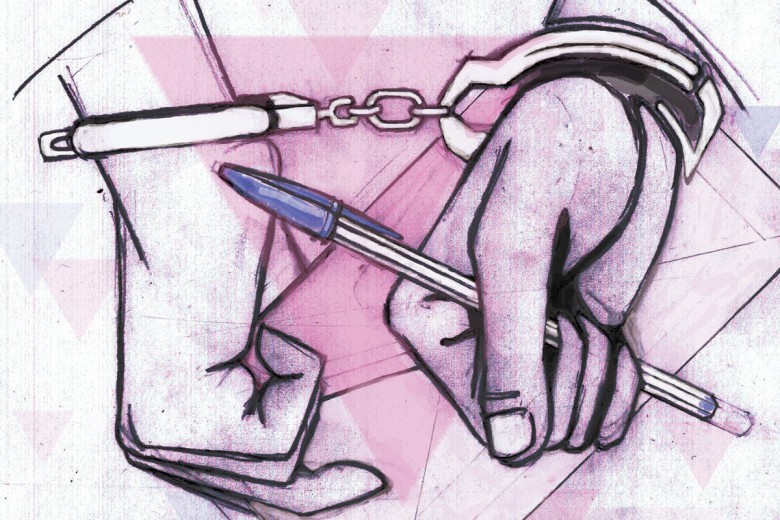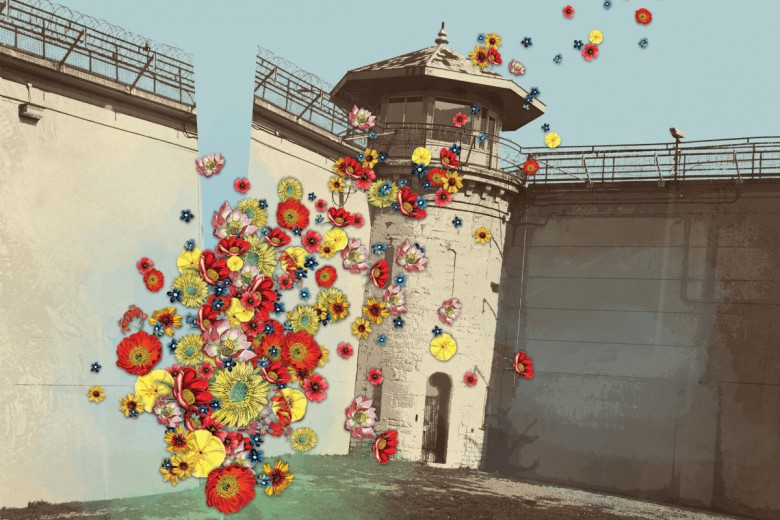When her mother moved to The Pas, MB, Breanna Kannick opted to stay with her aunt and uncle in Selkirk. But she’d visited The Pas, including in 2009 for her mother’s wedding, when she was the only one in the bridal party who could calm her sister Jamison, then three years old, at the hair salon. The little girl resisted having strangers tug and pull at her head for an indeterminate amount of time, and only holding Breanna’s hand for the entire appointment kept her still.
Even though Kannick had never actually lived in The Pas, when she called her mother, Sherri Chartrand, from a Regina jail in August 2015, Kannick had reached a turning point and she readily agreed to bus up there. The police had picked her up for failing to make a court date related to a prior drug charge, and she was going to be held on remand until her bail hearing. Chartrand wanted to check her into rehab for the opiate addiction Kannick had developed in (by Chartrand’s estimate) 2012. But that plan never transpired: five days after her arrest, Kannick was dead in her jail cell, one of the many Indigenous women who have been cycled through and failed by the Canadian correctional system.
Chartrand believes her daughter died of withdrawal-related complications. She is concerned about the quality of care her daughter received, and those concerns only grew when a second woman, Shauna Wolf, died in a different Saskatchewan jail in December, seemingly of the same issue.
While she was still adjusting to being in jail, Kannick called her mother on Tuesday, August 18; she was waiting for her Thursday court appearance. She’d told her mom that she wanted to go home, and Chartrand was planning to bail her daughter out, have a bus ticket waiting for her, and check her into rehab. That Tuesday, Kannick told her mother she was getting sicker as she began physical withdrawal from heroin and morphine. She hadn’t been given any sort of medication to soften the blow – a frequent palliative, as opiates are some of the hardest drugs to quit cold turkey – and said she hadn’t even seen a nurse. Chartrand was dumbfounded.
“That’s when I asked her to put a guard on the phone,” Chartrand said. “She said she asked a guard to talk to me, and they said no, that’s your phone time and you gotta use it.”
Chartrand expected to talk to her daughter the next day, but no phone call came. Thursday was Kannick’s bail hearing. Her bail officer had instructions to call Chartrand immediately after the hearing to tell her how much money she’d need to post bail for her daughter. That phone call didn’t come, either. Instead, that day Chartrand got a call from her own mother, who said there was talk on Facebook that Kannick was dead. The StarPhoenix had reported a death at the Regina jail, and friends had inferred, correctly, that it was Kannick.
“I said, no, if it’s on Facebook it’s probably a lie. It can’t be true. So I … I basically fell apart in the office at work. My boss had to bring me home. And I phoned White Birch [remand], I phoned her probation officer, I phoned everybody, and nobody was giving me any answers. They were saying that they couldn’t give me that information on the phone. And I said, ‘I’m her mother, somebody tell me what’s going on.’”
For its part, the Saskatchewan Ministry of Justice says it offers adequate and timely medical care to all inmates. Standard intake procedure includes a medical exam with a nurse, according to ministry spokesperson Drew Wilby, and any addictions or other medical issues should be noted at that time. Wilby also said, without going into detail, that the province has “protocols and policies” in place to ensure inmates who are dealing with addictions receive appropriate care.
After intake, however, inmates in Saskatchewan do not have access to 24-hour on-site elective (non-emergency) care. Rather, physicians make weekly visits to facilities and are otherwise on call, while nurses are on site for 16 hours a day. An inmate’s medical care is contingent on a guard’s decision to alert a nurse or doctor, a subjective process in which a guard’s assessment is more important than an inmate’s call for help.
Kim Pate is the executive director of the Canadian Association of Elizabeth Fry Societies (CAEFS), which advocates for women in the correctional system. Pate says the official process Wilby outlined, in which new inmates are examined upon intake and afterward have access to medically trained staff, isn’t always – or even often – the reality.
“The reality is, in many jails there’s not 24-hour medical care available,” Pate says. “They may be on call,” but the person who has to make that call – who has to decide if an inmate is sick enough to warrant bringing a doctor in – is a guard or other jail staff member with, in most cases, no medical training. In addition to lacking training crucial to assessing someone’s level of medical distress, correctional staff are just as likely as the general population to have negative attitudes toward people with drug addictions and the people they’re tasked with guarding.
Simone Davis runs an educational program called Walls to Bridges, which brings post-secondary students into correctional facilities to learn alongside incarcerated people. As an outsider with unusual access, Davis has been able to observe correctional facilities in a way few people other than staff and inmates can. She said that the system encourages guards to distrust the people they’re monitoring.
“Part of the training of a correctional officer is to be ever vigilant, to look out for what is described as ‘manipulative incarcerated people,’” Davis said. “The result is that certain kinds of human relationships, based on […] shared respect and civility, sometimes are harder to come by when there’s this basic belief that you have to be ever vigilant for manipulation.”
Another complicating factor when guards are in charge of health-care decisions is the over-incarceration of Indigenous peoples which, while an issue across Canada, is especially pronounced in the Prairie provinces. In 2011–2012, 43 per cent of women admitted to provincial and territorial custody were Indigenous. And as the Truth and Reconciliation Commission’s (TRC) 2015 final report details, the Canadian criminal justice system at every step “shows a reluctance to take the evidence of Aboriginal people as worthy of belief.” Thus, the distrust guards are encouraged to cultivate is compounded by the fact that many inmates belong to a group consistently deemed inherently untrustworthy, even in telling their own stories and experiences.
In recent years, Pate has examined, in addition to specific cases of wrongdoing like Ashley Smith’s 2007 death, the profoundly disproportionate incarceration of Indigenous women, especially in the Prairie provinces; the staggering rates at which Indigenous women are classified as dangerous and put into solitary confinement (officially termed “segregation” in Canada); and the lack of access to programs geared at treatment and rehabilitation many incarcerated women face. What emerges is a picture of a system ostensibly focused on both punishment and rehabilitation, but which in effect prioritizes the former over the latter.
Those attitudes are rarely made explicit but can be detected in the ways guards interact with inmates, and in the idea that incarceration is a choice. It’s a sentiment echoed far up the ladder of power: Saskatchewan Premier Brad Wall, for instance, responded to inmates’ protests against spoiled food at a Regina prison earlier this year by saying, “If you really don’t like the prison food, there’s one way to avoid it and that’s don’t go to prison.”
Chartrand says a woman reached out to her on Facebook to say she’d been in White Birch with Kannick and that guards had disregarded Kannick’s obvious medical distress and her cellmate’s request to move.
“They told the guards to let her [the cellmate] out of the cell and put her in another cell, because my daughter had been vomiting a lot, and sweating and yelling and screaming, pounding on the door,” Chartrand said. “The guards were calling her ‘pukey,’ and telling her, ‘oh, you better watch out, you’re gonna trip on your puke.’”
The Ministry of Justice conducts a coroner’s investigation into every death that happens in a correctional facility, though the purpose of that investigation is to establish the cause of death, not to find fault or address underlying issues. After that investigation, an inquiry is held in almost every case, and that’s where questions of inadequate medical care or neglect would come up. Even in an inquiry, Wilby said, the goal isn’t to assign blame, but to examine the system for any possible failings.
Preventing future deaths is urgent; it’s why Chartrand has been intent on speaking to the public about a family tragedy many people would have no interest in discussing. But accountability is also integral. In the TRC report, an entire chapter is devoted to the failures of the Canadian justice system regarding residential school survivors. Time and again, the TRC emphasizes that a key aspect of Indigenous justice is acknowledgement of wrongdoing. Failing to assess responsibility, seemingly as part of an attempt to avoid criminal charges, leaves families with no answers or closure.
As of mid-February, six months after Kannick’s death, the Justice Ministry said the coroner’s investigation is “approaching a close.” A criminal investigation following inquiries is never guaranteed. Chartrand has been in contact with the Elizabeth Fry Society of Saskatchewan, which she said has three lawyers working on her daughter’s case. Through her lawyer, Chartrand tries to stay in touch with the Justice Ministry, which she said has “not once” initiated contact with her.
While there were myriad points at which intervention could have resulted in a better outcome for Kannick, Pate said that one crucial change could have prevented all of this from happening.
“Prison is our most expensive, least effective way to deal with so many issues we currently use prisons for,” she said. “The financial cost is huge, the social cost is huge.”
There’s no reason to warehouse people who don’t pose a threat to public safety, says Pate. A non-violent drug offender could, and perhaps should, be released on the condition that they participate in some form of drug counselling or treatment.
Kannick’s mother echoed that sentiment. When she was first arrested, Kannick had drugs on her, but Chartrand says police let her daughter go on her own recognizance.
“I don’t understand that,” Chartrand said. “Why didn’t they at least offer her some help? Offer her to go to a rehab?”
Chartrand feels that her daughter is one of many Indigenous women who have been unfairly cast off by the government and systems supposedly designed to protect them.
“This is the ideological work that the prison performs,” writes Angela Davis in Are Prisons Obsolete? “It relieves us of the responsibility of seriously engaging with the problems of our society.”
Those problems are largely caused, in Davis’ calculation, by racism and capitalism. Canada’s specific reckoning with racism and prison informs its racist treatment of Indigenous peoples.
The 30th of the TRC’s 94 calls to action demands an end to the overrepresentation of Aboriginal people in provincial, territorial, and federal custody within 10 years, while call to action 36 requests that culturally relevant services, including services related to substance abuse, be made widely available to incarcerated Indigenous people. But even with a new federal government that claims to be focused on reconciliation with Canada’s Indigenous peoples, it’s uncertain how soon – if ever – these recommendations will be implemented.
Howard Sapers, the federal correctional investigator, said that while the justice minister’s mandate letter in 2015 included a commitment to a renewed nation-to-nation relationship with Indigenous peoples and to reducing the incarceration rates of Indigenous peoples, he isn’t aware of any substantive changes yet made.
For her part, Chartrand can’t stop wondering about all the people like her daughter who have been lost to the system. “I mean, who knows how often or how much this has happened,” she says quietly. “They’re just sloughing them aside, saying well, it’s just a drug addict. Or, like, these people don’t count, you know?”






_780_520_90_s_c1_c_b.jpg)
